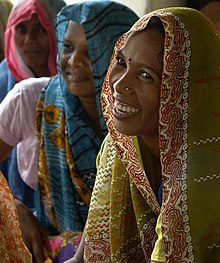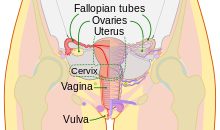Woman
A woman is an adult female human.[1] The plural of "woman" is "women". Young human females are called "girls". The word "women" is sometimes used to refer to females of any age (as in the phrase "Women's rights")




Women usually have less hair on their faces and bodies than men. After they finished puberty, and before menopause, women are usually able to get pregnant and give birth to babies.
Women have historically been treated differently from men. They have also been expected to act differently. In many places, the treatment of and expectations for women have changed with the spread of women's rights in the 20th century. Transgender women are male but socially live as women, and attracted more attention in the late 20th to early 21st century.
Biology
changeWomen have sex organs including a vagina, uterus, and ovaries from birth. After they become adults, women also have breasts to make milk for babies.
Women's bodies are usually different than men's bodies in some other ways, including:
- less pubic hair
- less facial hair
- less body hair
- smaller hands and feet
- narrower shoulders and chest
- wider hips
- smaller skull and bone structure
- smaller brain
- less muscle mass
- higher voice
- a shorter shinbone
Women are usually shorter than men. In 1996, the average height of women around the world was 159 cm.[2]
Pregnancy and childbirth
changeAn expert on the subject should have a look at this article or section. |
Between the end of puberty and menopause, a woman can become pregnant. Women go through puberty usually when they are between ten and sixteen years old. The menopause usually starts in the late forties, and ends in the early fifties. Between these ages, women go through a menstrual cycle, once a month. If such a woman has sex with a man, at the right time of the month, and no contraception is used, the woman may get pregnant.
Getting pregnant
changeA woman who has sex with a man, at the right time, may get pregnant, if no contraception is used. Contraception will stop a pregnancy. When she gets pregnant, the ovum of her menstrual cycle will be fertilized, and attach itself to the wall of the uterus. In humans, a pregnancy usually takes about 38 weeks. After this time, a child is born. For childbirth, a woman usually gets help from specially-trained people, called midwives. During the pregnancy, the woman should regularly see a doctor. Very often, these doctors are specialized, and are called gynecologists or obstetricians.
After the child is born, the woman will breast-feed her child for some time.
Sometimes women who are very young get pregnant. These pregnancies are known as teenage pregnancies; very often, they are more difficult than normal ones.
Keeping a pregnancy from starting
changeIf a woman had sex with a man, and no contraception was used, there's the risk of her getting pregnant. If she does not want to get pegnant, she has some time to take what is called emergency contraception. Emergency contraception protects against unwanted pregnancies, as it keeps the pregnancy from starting. It does not protect against sexually-transmitted diseases. Also, it will not work all the time. Very often, women who want to get emergency contaception also need to spend some time with a professional in a counselling session. Depending on the country, emergency contraception may not be available, or it may not be legal.
Stopping a pregnancy
changeHumans also have the possibility to stop a pregnancy, when it has started. Stopping a pregnancy is called abortion. When people do it on purpose, it is called induced abortion. Pregnancies that stop on their own are called spontaneous abortion, miscarriage or stillbirth. Depending on the country or region, a pregnancy can be stopped at any time, or there are limits, for how long it can be stopped. Pregnancies that have gone on longer are generally more difficult to stop.
Many countries have laws that say for what reasons, a pregnancy can be stopped. One of a common set of reason is that continuing the pregnancy would be dangerous to the woman. Another common reason is that the pregnancy was the result of a rape (the woman did not want to have sex with a person). Still another would be that the child would be born with certain birth defects. All of these reasons vary by country. In some countries, they also vary by area. Some countries are very liberal, others are more restrictive. Some countries or territories do not allow abortion at all.
During the pregnancy
changeDuring the pregnancy, the woman will change too. There are many things a woman should no longer do. Many drugs have a bad effect on the child growing inside her. The woman therefore needs to watch the drugs that she takes, and she needs to tell the people who give her the drugs (at the pharmacy) that she is pregnant. Note that drinking alcohol, or smoking cigarettes also has a bad effect on the unborn.
Giving birth
changeIn humans, a pregnancy lasts 266 days, on average. Most children are born within two weeks of the calculated date. Only four percent of the children are born on the calculated date. With birth, the unborn child leaves the womb.There are certain signs that a birth is about to occur:
- The womb (also called uterus) will contract regularly, at first about once every 10 minutes
- A slight bleeding
- The amniotic sac will break (this is called rupture of membranes)
- Either diarrhea or vomiting
A woman giving birth will feel pain, much more pain than other animals (such as the Great Apes).This is mainly due to the fact that the head is big, and the pelvis is rather small.
In many countries, hospitals are specially equipped to handle births. Giving birth at a hospital has the benefit that the woman can get help faster, if anything goes wrong. For this reason, most births happen at a hospital.
In some cases, people can also give birth at home.
Anonymous birth
changeSome countrires allow a woman to give birth anoymously. That way, the woman does not have to give her name, or much other personal information. The baby will then be given up for adoption, so that another couple can raise the child.
Giving the child away
changeIn many countries there are hospitals with baby hatches. A woman can put her child in such a hatch. The baby will be raised and cared for, and it will be given up for adoption. Many women who are unable to raise the child use baby hatches.
Rights
changeWomen have historically had less control over their lives than men. They have often been forbidden to own land, vote, hold political office, or choose whom they marry and discouraged from voicing political opinions or attending school. Since the beginning of the 20th century women have gained many rights in most of the developed world.
Women have also historically faced a lot of sexual violence, harassment, and discrimination. The amount of sexual violence, harassment, and discrimination has decreased with the spread of women's rights, but many women still face these problems.
Gender roles
changeWomen have historically been expected to bear and raise children, limit their public lives, and allow their male relatives to make decisions for them. These expectations have changed with the spread of women's rights.
Education
changeBefore modern societies, education of women was limited. In developed countries, most women have access to education, and even perform better than men at many levels. In the United States in 2005 and 2006, women have earned 62% of associate degrees, 58% of bachelor's degrees, 60% of master's degrees, and 50% of doctorates.[3][4]
Education, especially for women, has become more common in most countries in the 20th and 21st centuries than it was previously.
Women at work
changeIn most countries, women work, like men. Their jobs are sometimes different, and sometimes their work is what society expects. In jobs, that have ot do wirth education, or with healthcare, there are generally more women than men. If women and men do the same job, women often earn less for their work. This is known as gender pay gap. Also, there are fewer women in leading roles of companies.
Women in politics
changeSome women have become successful politicians. In 2019, about a quarter of all politicians were female. Nordic countries were in the lead, with over 42%. The fewest female politicians can be found in Oceania, with just over 16%, Middle East and North Africa, with 19%, and Asiatic countries with just under 20%.
In most countries, women have the same rights to vote, and to get elected than men. This has not always been the case. The question, whether women should be able to vote is called women's suffrage. Only very few countries in the world do not allow women to vote or to get elected.
Science, literature, and art
changeThroughout history, women have made contributions to science, literature, and art. There were many female writers, but many published their work under a male name. In music, women have been composers, songwriters, performers, singers, conductors, scholars, teachers, critics and more.
In the 18th century, biologists began using the symbol for the goddess Venus (♀️) as indicating a female plant or animal. It is often used for women.
Femininity
changeFemininity (also called womanliness or girlishness) is a set of attributes, behaviors, and roles generally associated with women and girls. Feminity is a social construct,[7] which is different in different societies. Some behaviors considered feminine are biologically influenced.[7][8][9][10] People do not agree about the extent in which femininity is sociallly or biologically influenced.[9][8][10] It is distinct from the definition of the biological female sex,[11][12] as both men and women can have feminine traits.
Related pages
changeReferences
change- ↑ "Definition of "woman"". merriam-webster.com. Retrieved 2022-01-17.
- ↑ Roser, Max; Appel, Cameron; Ritchie, Hannah (8 October 2013). "Human Height". Our World in Data.
- ↑ "Historical summary of faculty, students, degrees, and finances in degree-granting institutions: Selected years, 1869-70 through 2005-06". Nces.ed.gov. Retrieved 2014-08-22.
- ↑ Women (Still) Need Not Apply:The Gender and Science Reader. New York: Routledge. 2001. pp. 13–23.
{{cite book}}: Unknown parameter|authors=ignored (help) - ↑ Greer 2001, p. 142.
- ↑ James 1997, p. xiv.
- ↑ 7.0 7.1 Shehan, Constance L. (30 August 2018). Gale Researcher Guide for: The Continuing Significance of Gender. ISBN 9781535861175.
- ↑ 8.0 8.1 Lippa, Richard A. (6 May 2005). Gender, Nature, and Nurture. ISBN 9781135604257.
- ↑ 9.0 9.1 Masculinity and Femininity in the MMPI-2 and MMPI-A. 2010. ISBN 9781452900032.
- ↑ 10.0 10.1 Wharton, Amy S. (4 February 2009). The Sociology of Gender: An Introduction to Theory and Research. ISBN 9781405143431.
- ↑ "Gender, Equity and Human Rights". Archived from the original on 2014-09-23.
- ↑ Ferrante, Joan (January 2010). Sociology: A Global Perspective (7th ed.). Belmont, CA: Thomson Wadsworth. pp. 269–272. ISBN 978-0-8400-3204-1.